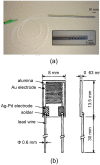Smart Portable Devices Suitable for Cultural Heritage: A Review
- PMID: 30050013
- PMCID: PMC6111338
- DOI: 10.3390/s18082434
Smart Portable Devices Suitable for Cultural Heritage: A Review
Abstract
This article reviews recent portable sensor technologies to apply in the Cultural Heritage (CH) fields. The review has been prepared in the form of a retrospective description of the sensor's history and technological evolution, having: new nanomaterials for transducers, miniaturized, portable and integrated sensors, the wireless transmission of the analytical signals, ICT_Information Communication Technology and IoT_Internet of Things to apply to the cultural heritage field. In addition, a new trend of movable tattoo sensors devices is discussed, referred to in situ analysis, which is especially important when scientists are in the presence of un-movable and un-tangible Cultural Heritage and Art Work objects. The new proposed portable contact sensors (directly applied to art work objects and surfaces) are non-invasive and non-destructive to the different materials and surfaces of which cultural heritage is composed.
Keywords: Cultural Heritage (CH); ICT; IoT; Sensors; actuators; air quality control; analytical diagnosis; graphene; graphene oxide (GO); in situ restoration; integrated sensor arrays; mobile Laboratory; movable devices; nanomaterials.
Conflict of interest statement
The authors declare no conflict of interest.
Figures






References
-
- Rittersma Z.M. Review: Recent achievements in miniaturised humidity sensors—A review of transduction techniques. Sens. Actuators A Phys. 2002;96:196–210. doi: 10.1016/S0924-4247(01)00788-9. - DOI
-
- Chen L.T., Lee C.Y., Cheng W.H. MEMS-based humidity sensor with integrated temperature compensation mechanism. Sens. Actuators A Phys. 2008;147:522–528. doi: 10.1016/j.sna.2008.06.033. - DOI
-
- Prosek T., Kouril M., Dubus M., Taube M., Hubert V., Scheffel B., Degres Y., Jouannic M., Thierry D. Real-time monitoring of indoor air corrosivity in cultural heritage institutions with metallic electrical resistance sensors. Stud. Conserv. 2013;58:117–128. doi: 10.1179/2047058412Y.0000000080. - DOI
-
- Albertano P., Bruno L., Bellezza S. New strategy for the monitoring and control of cyanobacterial films on valuable lithic faces. Plant Biosyst. 2005;139:311–322. doi: 10.1080/11263500500342256. - DOI
Publication types
LinkOut - more resources
Full Text Sources
Other Literature Sources

